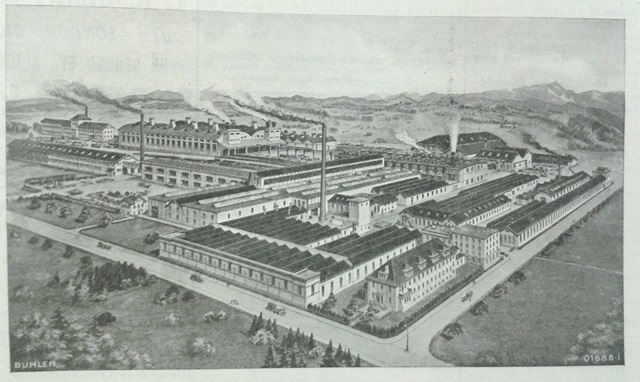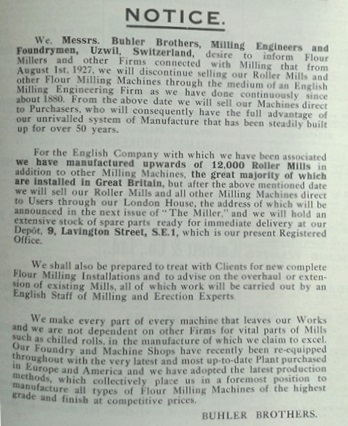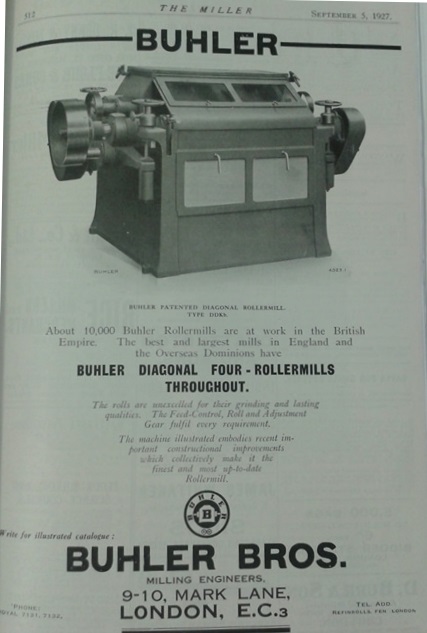Manufacturers: Bühler
Adolf Bühler founded a cast iron foundry in Uzwil, Switzerland, on the 10 February 1860. In the first year of production, Mr. Bühler and two employees made 23 tons of iron casting, mainly used for knitting machines. 150 years later, the firm Adolf Bühler founded is a flourishing international supplier of over 300 different types of machinery, including milling machines.

Bühler first started to produce milling machinery in 1872, when they started to make cast iron rollers. By 1876, they were selling rolls of 300mm, and by 1880 they were also manufacturing ‘semolina purifiers, plan sifters, mixing machines, grain-cleaning and -drying machines’ (150 Years of Innovations). In 1880, many mills throughout the world were still working on the old millstone system, as roller mill manufacture was still in its infancy. However, Bühler could already produce machinery for an entire roller system and, by 1890, could also build whole mills and silos. The firm was therefore already establishing itself as one of the leading suppliers of milling machinery in Europe.
This status as a leading producer of milling machinery was re-enforced throughout the 19th century, as they started producing new and pioneering technology. In 1887, they produced a 4-roller mill with a width of 1,000mm, which ‘had previously been declared impossible by milling industry experts’ (150 Years of Innovations). Nine years later, they improved on this by producing rolls with a width of 1,500mm, again proving the impossible possible.
The success of the firm within the milling industry meant it quickly gained international success and recognition. In 1880 they established a representative agreement with the United Kingdom; in 1891 they received an agency contract for Russia and founded a subsidiary company in Paris. By 1896, they had supplied 8,220 roller mills to these three nations alone. Trade in Europe was therefore profitable for the firm.

Part of this European trade included an agreement with the British firm Henry Simon Ltd. Details about the arrangement are unclear, but it was ‘well-known that Bühlers became manufacturers and suppliers of Simon roller mills’ (Jones, p.160). So it was that the Swiss manufacturers produced machinery for the British engineering firm. This partnership lasted from the 1880s to the late 1920s, when Henry Simon Ltd. established the new Cheadle Heath engineering works, meaning the arrangement was no longer required. Even when announcing the end of their partnership, Bühler did not mention Henry Simon Ltd. by name: ‘from August 1st 1927, we will discontinue selling our Roller Mills and other Flour Milling Machines through the medium of an English Milling Engineering Firm as we have done continuously since about 1880’ (The Miller, July 4, 1927). Despite the partnership being at an end, Bühler machinery could still be purchased ‘direct’ from the Swiss firm.
Although this arrangement between Simon and Bühler was not prominently advertised, there was another partnership between the two firms which was more well-known. In 1892, the firm Simon, Bühler & Baumann was founded in Frankfurt. This firm became ‘one of the three or four leading milling engineering firms in Germany until its confiscation during the First World War’ (Simon, p.12). Given the wealth of experience the firm had, just in the form of Simon and Bühler, it is unsurprising that it became a leading milling engineering firm.

Bühler on its own was also flourishing at this time. By the end of the 19th century the firm could build and fit an entire mill system, which led to orders coming in from all over Europe. Indeed, they sold their 10,000th roller mill on 23 August 1894, bound for Weinheim, Baden. In 1900 they received a gold medal for their stand at the Paris World’s Fair, which included the Weyermann plansifter, which was the ‘first not to hang from the ceiling, but instead is mounted to the floor’ (150 Years of Innovations). Therefore, the firm entered the 20th century in a strong position.
However, a change had taken place within the firm at the end of the 19th century. In October 1896, the founder, Adolf Bühler, suddenly died. His eldest son, Adolf Bühler Jr., had joined the firm in 1893 and it was he that then became Manager of the company. He was joined by his brother, Robert, in 1901 and the Bühler Brothers partnership was formed. Four years later, two more brothers, Otto and Theodor, joined the firm and just over ten years after that, a fifth brother, Walter, also joined the family firm, after completing his engineering studies in 1916.
Under the leadership of this new generation of Bühler’s, the firm continued to grow with the building a new assembly shop in 1910 and the opening of a new foundry, along with new offices, in 1912. They also expanded their presence internationally opening a new office in New York in 1924. In the following five years, further subsidiaries and sale offices were established in Romania, Poland, Argentina, and Egypt. Given this expansion, the number of workers employed by the firm also rose. Indeed, the figure of two employees, from when Adolf Bühler founded the company in 1860, had already increased to 739 by 1900. By the eve of the Second World War, this figure was up to 2,000, with facilities, such as works canteens, provided by the firm. However, until 1910 all of these employees had been male. Then on 2 June 1910, the first two female employees were hired as seamstresses, who worked sewing plansifter hoses, filter hoses and strainer linings.
Throughout the 20th century, the firm continued to create innovative machines, and made use of the new technology that was available. In 1908 they started using pneumatic conveyer systems in their manufacturing process, and then in 1944, started installing pneumatics into milling systems. In 1950 Bühler’s were credited with another new innovation by producing the first centrifugal cast rollers with a rotating chill mold, instead of using a clay core. The firm was maintaining its reputation as pioneering mill machine manufactures.

Along with mill machine design and technology, Bühler also became leaders of education. In 1955, René Bühler, son of Adolf Bühler Jr., initiated the foundation of the engineering school Abendtechnikum St. Gallen, now the HTL Engineering School. Two years later he also founded the Swiss Milling School in Saint Gall. When this school celebrated its 50th anniversary in 2007, it could boast to having trained 1,100 students, from over 80 countries, in the ways of milling. Along with general engineering and milling schools, Bühler also established a school for animal feed techniques and a ‘school mill as an educational center for Buhler’s customer’s employees’ (150 Years of Innovations). This first school mill established in 1985 was not the last school mill that Bühler’s would establish, indeed, by 1995 they could also be found in Morocco, China, Egypt, Algeria and India.
The construction of school mills in countries other than Switzerland demonstrate the worldwide presence the firm had gained. Indeed, since establishing the first few subsidiaries, many more had been founded in countries throughout the world, including Brazil, China, Iran, Japan, Mexico, Russia, South Africa, and Sri Lanka. The main impetus behind making Bühler an international company came from the third generation of Bühler’s. Adolf Bühler Jr. died in 1939; Otto Bühler died in 1946; whilst Walter Bühler retired in 1949, ending the second generation’s involvement with the firm. The third generation consisted of Adolf Bühler Jr. two sons’, René and Adolf, and their cousin, Rolf. They continued to run the family company and were responsible for founding many subsidiaries that helped make Bühler the international company that it is today.

This worldwide expansion naturally led to a growth in the number of employees. As already stated, by the eve of the Second World War, the firm hired 2,000 employees, yet most of these were mainly based at the factory in Switzerland. By 1970, Bühler hired almost that many employees to work in their international offices, whilst in Switzerland they employed 3,630 workers. This trend of a growing number of employees away from the Swiss base continued. By 2010 the firm employed over 7,000 individuals, yet only a third of them worked in Switzerland. Another change that took place was the growth in the number of women employed. A book released to celebrate the 150th anniversary of the firm, contained profiles of 65 different individuals. These 65 individuals included eight women who were working in a variety of different roles, from Vrushali Patil, who was about to become head of the Bühler demonstration lab in Bangalore, to Esther Zaugg, Head of International Human Resources, and Cheryl Kolapen, a project engineer in Bühler Johannesburg (150 Years of Innovations, pp.160-163; 229-231; 103-106). The firm had certainly come a long way from hiring just two employees in 1860 and two female employees in 1910.
Whilst changes and advancements have taken place in the Bühler firm, one constant has been the involvement of the Bühler family. After the involvement of the third generation, René Bühler’s son, Urs Bühler, represented the fourth generation becoming Chairman of the Board of Directors. Urs Bühler then retired from this position in 2014 and transferred his shares in Bühler, the following year, to his three daughters, Jeannine, Maya, and Karin, bring the fifth generation into the firm.
Today, Bühler is an international manufacturer of die-casting machines, chocolate manufacturing machines, pasta making machines and, of course, milling machines. Indeed, around ‘two thirds of wheat, corn and rice consumed worldwide are ground or processed using a Buhler plant’ (150 Years of Innovations, p.12). Plants and subsidiaries have been established throughout the globe, as Calvin Grieder, who took over from Urs Bühler as Chairman of the Board, stated in 2010, ‘We are no longer an export firm, but an international enterprise’ (150 Years of Innovations, p.11). The small cast iron foundry founded by Adolf Bühler in 1860 has come a long way.
Sources:
*Image of Bühler Customer Center from Wikimedia Commons, (CC BY-SA 3.0) by Bühler Group*
*Image of new Bühler machinery from Wikimedia Commons, (CC BY-SA 3.0) by Bühler Group*
Buhler AG, Buhler. 150 Years of Innovations for a Better World (Uzwil, 2010).
Bühler, 100 years Buhler Brothers Uzwil, Switzerland (1961).
http://www.tagblatt.ch/altdaten/tagblatt-alt/tagblattheute/wv/uzwil/wv-uz/art810,83473
Simon, Anthony, The Simon Engineering Group (Stockport, 1953).
The Miller, July 4, 1927.
